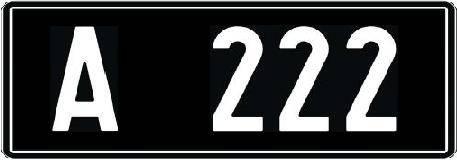Регистрационные знаки транспортных средств (Эстония)
Код Эстонии для международного движения транспортных средств — (EST).
Стандартные номерные знаки Эстонии формата «123 АБВ» была введена в 1992 году. В этом формате 123 — номер, A — код региона, БВ — серия. В 2004 году, после вступления страны в ЕС, номерные знаки были дополнены европейской символикой и кодом страны на синем фоне.
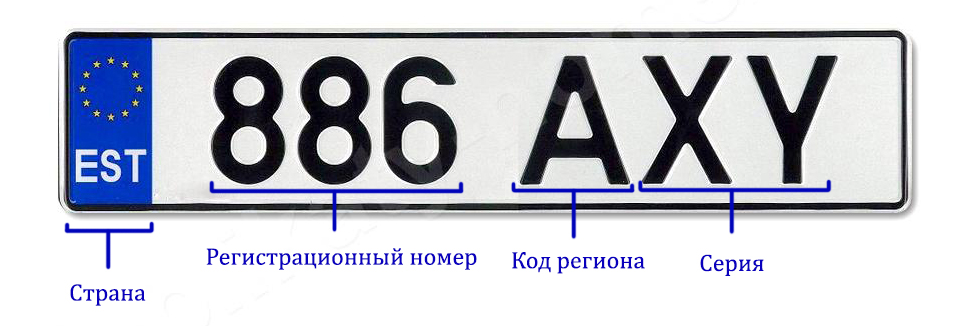
Размеры: 520х112 мм
Все: 250 г.
Материал: алюминий
В 1991 году в Эстонии были введены региональные коды, которые присваивались номерам в соответствии с тем регионом, где автомобиль был зарегистрирован.Поскольку процесс смены регистрации авто уже давно лишен бюрократии и сложностей, зачастую региональный код говорит о месте, где обычно проживает владелец автомобиля. Статистика показывает, что владельцы авто в Эстонии предпочитают менять место регистрации вместе со сменой жительства.
Региональные коды Эстонии
| Буква | Регион |
|---|---|
| A | Таллин |
| В | Таллин |
| D | Вильяндимаа |
| F | Пярнумаа |
| G | Валгамаа |
| H | Хийумаа |
| I | Ида-Вирумаа |
| J | Йыгевамаа |
| K | Сааремаа (Курессааре) |
| L | Рапламаа |
| M | Харьюмаа |
| N | Нарва |
| O | Пылвамаа |
| P | Ярвамаа (Пайде) |
| R | Ляэне-Вирумаа (Раквере) |
| S | Ляэнемаа (Хаапсалу) |
| T | Тартумаа |
| V | Вирумаа |
В 2004 году подавляющее большинство региональных кодов, кроме М и Т, были отменены. Все остальные регионы получили Таллинские коды А и В. Выданные до 2004 года номерные знаки с региональным кодированием остаются в силе.
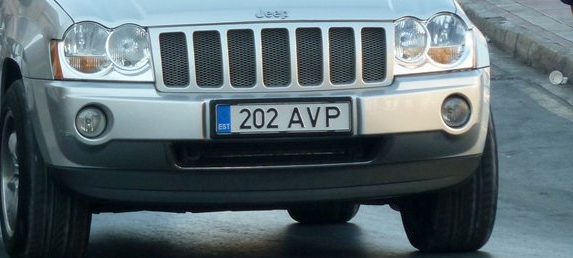
Какие бывают типы автомобильных номеров Эстонии (со спецсериями):
| Фото номера | Тип. Описание знака |
|---|---|
 | Общий — выдаётся легковому, грузовому транспорту и автобусам, формат: «три цифры три буквы». C 2010 года в переменной части регулярных номерных знаков не используются гласные буквы (A, E, I, O, U, Y) |
 | Индивидуальный. Владелец автомобиля по желанию может заказать себе индивидуальный номер с произвольным сочетанием букв и цифр. Основное требование — номер должен содержать как минимум букву и цифру, максимальное число символов в номере — не больше семи, включая пробелы. Индивидуальный номер выдаётся за дополнительную плату. Существует 2 вида индивидуальных номеров: «заказная серия» и полностью индивидуальный номер. Заказная серия — это произвольное сочетание цифр и букв, не нарушающее формата (например, «666 USA»); по состоянию на 2016 год такой номер стоит 470 евро. Индивидуальный номер — номер с абсолютно произвольным сочетанием букв и цифр (например, «RUSSIA7»); такие номера, конечно, интереснее, но стоят в 4 раза дороже заказных серий. |
 | Дилерские номера для тест-драйва. Первое время дилерские номера были того же формата, что и обычные, но выполнялись белыми символами на зелёном фоне. Просуществовали такие номера недолго и уже в середине 1990-х годов были заменены номером текущего стандарта, формат: PROOV и четыре цифры, цветовая гамма — как у обычных номеров. Для автомобилей американского и японского производств существует двухрядное исполнение номерного знака: в верхнем ряду располагается слово «PROOV», в нижнем — цифры. |
 | Для автомобилей с американским стандартом номерных знаков формат: «две цифры три буквы», первая буква всегда Z (при заказе серии можно выбрать любое сочетание букв), пластина номера короче, но шире. |
 | Для автомобилей, зарегистрированных иностранными гражданами, формат: «три цифры три буквы», первые две буквы всегда EE , выполняется чёрными символами на жёлтом фоне. Для автомобилей американского производства применяется сокращённый формат, число цифр в нём на одну меньше, буквосочетание чаще всего EEZ . На текущий момент, данный вид знака выдаётся в крайне редких случаях. |
 | Для прицепов. До 2009 года формат прицепных номеров был «три цифры две буквы», в 2009—2010 году на прицепы стали выдавать автомобильные номера американского стандарта (первая буква была H , последняя — Z ), с 2010 года формат прицепных номеров совпадает с автомобильными, первая буква номера — Y . |
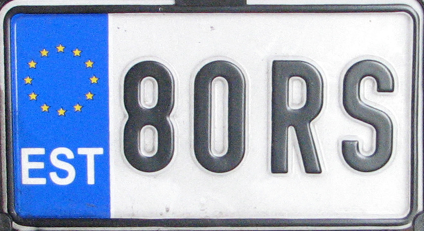 | Мотоциклетный. До 2001 года мотоциклетные номера были двухрядные, сверху располагались три цифры, снизу — две буквы, форма пластины — вытянутый по вертикали прямоугольник. В 2001 году формат был сменён на однорядный «две цифры две буквы». Как на автомобили, на мотоциклы можно заказать индивидуальный номер. |
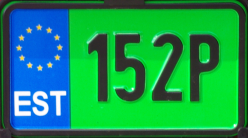 | Для мопедов, формат: «три цифры буква», выполняется чёрными символами на зелёном (ранее — салатовом) фоне, введён с 1 июля 2011 года. |

| Дипломатический, выдаётся с 1995 года. Формат: «две буквы четыре цифры» (до 1996 года первая цифра печаталась слитно с буквами) или «три буквы три цифры», выполняется белыми символами на голубом фоне. Первый формат используется для автомобилей сотрудников посольств (первые две буквы CD) или техперсонала (первые две буквы AT), второй формат используется только на личных автомобилях послов и консулов, буквы обязательно CMD. Первые две цифры в обоих номерах — код страны. Для автомобилей американского производства применяются сокращённые форматы, число цифр в них на одну меньше. |
 | Транзитный, формат: «две буквы — четыре цифры» (для автомобилей, в исключительных случаях — для прицепов) или «две буквы — три цифры» (для прицепов, тракторов, мотоциклов и мопедов), выполняются красными символами на белом фоне. |

| Военный, формат совпадает с форматом общего, прицепного, мотоциклетного или тракторного номеров (в зависимости от типа зарегистрированного транспортного средства), но выполняются белыми символами на чёрном фоне; синяя полоса с флагом ЕС и кодом Эстонии отсутствует. Для автомобилей также предусмотрен «американский» вариант, а с 2013 года — и двухрядный вариант номера. |
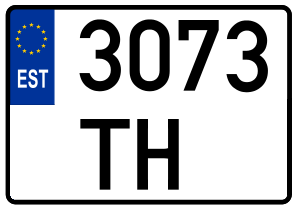
| Тракторы. В 2009 году отдельный формат для тракторных прицепов был отменён, вся сельхозтехника и прицепы к ней теперь регистрируются номерами тракторного формата серии TH, тогда же ввели однорядную разновидность тракторного номера в формате «четыре цифры две буквы». |
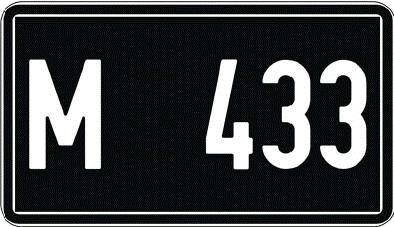
| Номера ретро-техники. На старые автомобили и мотоциклы можно получить свой вид номерных знаков: выполняются белыми символами на чёрном фоне, форматы — буква М и три цифры для мотоциклов, буква А и три или четыре цифры для автомобилей. До октября 2008 года на номерах помещался прямоугольник с евросимволикой, после октября 2008 года его перестали помещать на номерной знак. На такие номера также имеется возможность купить заказную серию, но не индивидуальный номер. |
 | Номера спортивных автомобилей. Формат номера: « SP четыре цифры», слева — синий прямоугольник с евросимволикой, выполняется белыми символами на красном фоне, введён в 2009 году. Спереди номер наклеивается и имеет меньше размер чем задний номер, а задний имеет стандартную форму и металлическое основание. |
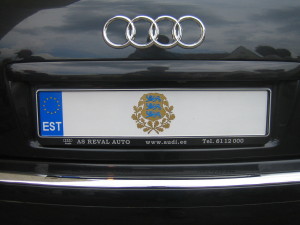 | Президентский номер. Представляет собой белую пластину с нарисованным посередине гербом Эстонии. |

Current Estonian license plate type A1
Vehicle registration plates of Estonia are divided into 18 categories, the most common of these (A1) is composed of three numbers and three letters (e.g. 123 ABC). Most registration plate types have black letters on a white background, and the plates are the same size and length as other European plates (520 × 113 mm). Previously the first of the three letters indicated the region of Estonia in which the car was registered; however, as of 2013, this is no longer the case. The third digit from the numbers indicated states when the car is due an inspection. It can be inspected up to 2 months after that digit. The registration plates are printed on an aluminium sheet with minimum thickness of 1 mm and must fulfil the requirements of ISO 7591:1982. All plates are issued with the blue European Union identification label, except types A9 and B2.
Types of plates[edit]
These are the different types of plates in use in Estonia:[1]

- A1 – Plates for general use on cars and trailers (vehicle categories M, N and O).
- A2 – Special-order plate. Must contain at least one letter and one number up to a total of 9 characters. Numbers and letters may not alternate.
- A3 – Plates for general use with reduced size. Usually used on cars with American origin, contains two numbers and three letters (historically beginning with Z).
- A4, A5 – General diplomatic plates with white letters on a blue background. A4 plates consist of two letters (usually CD) and four numbers, A5 are restricted to heads of diplomatic missions and consists of three letters (usually CMD) and three numbers.
- A6, A7 – Diplomatic plates with reduced size. A6 plates consist of two letters (usually CD) and three numbers, A7 are restricted to heads of diplomatic missions and consist of three letters (usually CMD) and two numbers.
- A8 – Transferable plates, used by car dealers. Consist of the letters PROOV (Estonian for test) and four numbers.
- A9 – Plates for classic and antique cars and trailers. Old vehicles are specifically defined vehicles (at least 35 years old) that have been granted an official old vehicle status. The plates consist of one letter and three numbers in white on a black background.
- A10 – Plates for racing cars, two letters, which are SP (sport) and four numbers that start with 0 in white on a red background.
- A11 – Transferable plates with reduced size.
- B1 – Plates for motorbikes and terrain vehicles (ATV’s, snowmobiles and similar), consist of two numbers and two letters.
- B2 – Plates for classic and antique motorbikes, mopeds and terrain vehicles, similar to A9 but consist of one letter and three numbers.
- B3 – Plates for mopeds. Mopeds are two to four-wheeled vehicles with engine displacement of 50 cm³ or less and maximum speed of 45 km/h or less. The plates consist of three numbers and one letter in black on a green background.
- D1 – Transit plates for cars, consist of two letters, a dash and four numbers in red on a white background.
- D2 – Transit plates for motorbikes, mopeds, tractors and special-purpose vehicles and their trailers, similar to D1 but with three numbers instead of four.
- E1 – Plates for tractors, special-purpose vehicles and their trailers, consist of two letters and four numbers on the next line.
Diplomatic codes[edit]
These are the two-digit codes used on Estonian diplomatic plates, beginning in 1992.
| Code | Country | Code | Country | Code | Country | Code | Country |
|---|---|---|---|---|---|---|---|
| 10 | Sweden | 20 | Australia | 30 | USA | 49 | European Union |
| 11 | Germany | 21 | Norway | 31 | 50 | Nordic Council | |
| 12 | Iceland | 22 | Diplomatic Transport | 32 | |||
| 13 | Canada | 23 | Hungary | 33 | China | ||
| 14 | Finland | 24 | Spain | 34 | Poland | ||
| 15 | France | 25 | Latvia | 35 | Japan | ||
| 16 | Denmark | 26 | New Zealand | 36 | Ukraine | ||
| 17 | United Kingdom | 27 | Austria | 39 | Georgia | ||
| 18 | Netherlands | 28 | Russia | 43 | Azerbaijan | ||
| 19 | Italy | 29 | Lithuania | 44 | Brazil |
History[edit]

Former Estonian plate, issued in 1998

Pre-1991 Estonian registration plate
On July 1, 1907, the City Board of Tallinn issued a decree concerning the moving, registering and taxation of motor vehicles. The cars only had a rear license plate, whose color varied every year. Other city council in the gouvernements of Estonia and Livonia issued similar decrees, some of which were still valid until the mid-1920s. The size and color of the plate was decided independently by every council. Chiefly they only carried the order of registration, sometimes the name of where the plate had been registered or a shortened form of it.
On August 27, 1920, the City Council of Tallinn favored the decree «On the compulsory registration of automobiles and motorcycles within the limits of the city of Tallinn,» an evolution of the Tsarist decree. Cars still only had a rear license plate, and the color still varied every year. The plates were made of tin carrying numbers starting with 1.
On December 7, 1922, the decree was changed. Motorists were ordered «upon fastening a tin order number to the rear of their vehicle, to add a white iron plate in a visible spot in front of the car (under the radiator) on which the order number given by the city council has been printed.» Since car owners were able to do a test drive before the technical inspection, a «test» number valid for three days was issued. It had to differ from the current number by shape and size. The plates of the previous tax year had to be changed to the current ones until May 15.
From 1923, Tallinn license plates became four-digit. Plates starting with 1 (from 1001) belonged to members of the Union of Estonian car owners as per a contract signed with the city council of Tallinn, and plates starting with 2 (from 2001) were issued for other cars. This decree lasted until the end of the 1925/26 tax season.
From then on all cars registered in Tallinn had unitary license plates starting with 2. Motorcycles were registered differently, the numbers were three-digit starting with 101.
In 1925, when the Tallinn and Harjumaa plates were manufactured in Aleksander Karja’s engraving shop, the font changed. The color of the plates still varied per tax year. For the 1928/29 season they were green with black font.
For the following 1929/30 tax season the financing sector of the city council planned for plates with white font on black background, but the new regulation for registering motor vehicles declared unitary license plates on May 14, 1929, which were required to be changed until July 1. Because this regulation appeared after the beginning of the new tax year, the new black plates were already prepared and had to be melted down.
The new regulation had something important missing: test numbers were now exclusive to car dealers and working places. If a civilian repaired a car or motorcycle in his own home, he lacked the legal chance to bring his vehicle to the technical overview, as test numbers could not be given out to private persons and driving without a number was prohibited as well. As a solution, the city council of Tallinn issued the 1929 tax year plates as test numbers for private car and motorcycle owners. These were now red with black font starting from 3001 for cars and 301 for motorcycles, written above the numbers on the rear plate was PROOV (test). This started a discussion in the city council with the Road Ministry when its representatives saw cars and motorcycles with red license plates on the street. Nevertheless, in August 1929, the decree was accepted by the Road Ministry and allowed vehicle owners to drive to the technical overview without a number, but with a 3-day test plate on the basis of a written declaration. This decree remained unchanged until the end of the first republic.
After the USSR’s pact of mutual assistance in the fall of 1939, several Red Army trucks without license plates arrived in Estonia. As it was forbidden to drive without license plates in Estonia, they were given Estonian license plates. One such truck with the plate A-2798 is known to have been involved in an accident with a 14 year old cyclist on April 17, 1940.
On April 19, 1941, the Estonian SSR Informer (Eesti NSV Teataja) published the People’s Commission of the Estonian SSR’s decree for registering vehicles. Following this, the People’s Commission of the Interior’s militia government was missioned to replace all old license plates and technical passes with the new ones until June 1, 1941. The basis for the plates was the People’s Commission of the Interior of the USSR decree on registering motor vehicles from July 22, 1939. The new plates were black with white ciphers in the format ER-12-34 and ES-12-34, but differed in size and shape completely from other Soviet license plates. Manufactured in Estonia, the front and rear plates were 112×340 mm and with the 1939 rift (Soviet rear license plates were square at the time) ER motorcycle plates were 85×255 mm, with the number printed on both sides on the front plate.
On November 18, 1941, the German occupying powers issued a decree for registering and reregistering vehicles. The plates were white with «Est» in black letters and a five digit number. On top of this, a so-called consent of registration, the Zulassungsausweis (at first called Zulassungsbescheinigung) had to be attached inside the windscreen.
For reasons unknown, General Commissioner in Estonia Litzmann did not like the decree issued by the Estonian Home-Rule Government and stopped the issue of the «Est» plates in early January 1942. Until the end of the year, all plates issued with occupational technical passes and registration consents were valid:
1. Republic of Estonia license plates (most of them 1940, a few 1939)
2. 1941 ESSR ER and ES plates
3. Estonian Home-Rule Est plates.
From January 1, 1943, the German highway code was valid in Estonia and all local vehicles were issued German plates starting with RO (Reichskommissariat Ostland) Estonian numbers were limited to RO-10000 – 29999.
These plates were issued until the Red Army occupied Estonia in the fall of 1944.
The first, post-Soviet, Estonian registration plates (1991) were composed of three numbers, with a licence label in the middle of the plate. The labels were dropped in 2004.
Only two suffixes were used on Soviet era plates: ЕА and ЭС. Neither identified any specific town or city, but rather served to inform that the vehicle had been registered in the Estonian SSR. There were plans to introduce an additional ЕС suffix, but as this occurred just before the collapse of the Soviet Union, the mark was subsequently allocated to the Russian city of St. Petersburg.[2]
Car designations (1991–2004)[edit]
- A and B – Tallinn
- D – Viljandimaa
- F – Pärnumaa
- G – Valgamaa
- H – Hiiumaa
- I – Ida-Virumaa outside of Narva
- J – Jõgevamaa
- K – Saaremaa (K as Kuressaare)
- L – Raplamaa
- M – Harjumaa outside of Tallinn
- N – Narva
- O – Põlvamaa
- P – Järvamaa (P as Paide)
- R – Lääne-Virumaa (R as Rakvere)
- S – Läänemaa (S as Haapsalu)
- T – Tartumaa
- V – Võrumaa
Special plates[edit]

Plate used on a Defense Forces vehicle
![]()
Plate used on the car of the President
- Temporary license plates are printed on a yellow background.[1]
- For vehicles registered in Estonian Defense Forces vehicle register, white characters on a black background are used. Two letter combinations start with K, three letter combinations with EK.[3]
- On the President’s vehicle the official plate number is not used and the plate bears the coat of arms of Estonia instead.[4]
References[edit]
- ^ a b «Riiklikele registreerimismärkidele ja nende valmistamisele esitatavad nõuded». Act No. 49 of 21 June 2011 (in Estonian). Retrieved 21 March 2017.
- ^ ru:Индекс автомобильных номеров СССР#Факты
- ^ «Kaitseväe ja Kaitseliidu sõidukite ja haagiste registreerimistunnistuse vorm ning riikliku registreerimismärgi valmistamise nõuded». Act No. 101 of 11 November 2011 (in Estonian). Retrieved 21 March 2017.
- ^ «Nõuded alates 1. jaanuarist 1997. a liiklusregistrisse kantud või kantavale sõidukile, välja arvatud enne 1. jaanuari 1987. a valmistatud või esmaregistreeritud sõidukid ning 30-aastased ja vanemad sõidukid». Lisa No. 1 of 13 June 2011 (PDF) (in Estonian). Retrieved 21 March 2017.
External links[edit]
- Olav’s plates Estonia
- Where’s that vehicle come from?
- Estonian license plates

Current Estonian license plate type A1
Vehicle registration plates of Estonia are divided into 18 categories, the most common of these (A1) is composed of three numbers and three letters (e.g. 123 ABC). Most registration plate types have black letters on a white background, and the plates are the same size and length as other European plates (520 × 113 mm). Previously the first of the three letters indicated the region of Estonia in which the car was registered; however, as of 2013, this is no longer the case. The third digit from the numbers indicated states when the car is due an inspection. It can be inspected up to 2 months after that digit. The registration plates are printed on an aluminium sheet with minimum thickness of 1 mm and must fulfil the requirements of ISO 7591:1982. All plates are issued with the blue European Union identification label, except types A9 and B2.
Types of plates[edit]
These are the different types of plates in use in Estonia:[1]

- A1 – Plates for general use on cars and trailers (vehicle categories M, N and O).
- A2 – Special-order plate. Must contain at least one letter and one number up to a total of 9 characters. Numbers and letters may not alternate.
- A3 – Plates for general use with reduced size. Usually used on cars with American origin, contains two numbers and three letters (historically beginning with Z).
- A4, A5 – General diplomatic plates with white letters on a blue background. A4 plates consist of two letters (usually CD) and four numbers, A5 are restricted to heads of diplomatic missions and consists of three letters (usually CMD) and three numbers.
- A6, A7 – Diplomatic plates with reduced size. A6 plates consist of two letters (usually CD) and three numbers, A7 are restricted to heads of diplomatic missions and consist of three letters (usually CMD) and two numbers.
- A8 – Transferable plates, used by car dealers. Consist of the letters PROOV (Estonian for test) and four numbers.
- A9 – Plates for classic and antique cars and trailers. Old vehicles are specifically defined vehicles (at least 35 years old) that have been granted an official old vehicle status. The plates consist of one letter and three numbers in white on a black background.
- A10 – Plates for racing cars, two letters, which are SP (sport) and four numbers that start with 0 in white on a red background.
- A11 – Transferable plates with reduced size.
- B1 – Plates for motorbikes and terrain vehicles (ATV’s, snowmobiles and similar), consist of two numbers and two letters.
- B2 – Plates for classic and antique motorbikes, mopeds and terrain vehicles, similar to A9 but consist of one letter and three numbers.
- B3 – Plates for mopeds. Mopeds are two to four-wheeled vehicles with engine displacement of 50 cm³ or less and maximum speed of 45 km/h or less. The plates consist of three numbers and one letter in black on a green background.
- D1 – Transit plates for cars, consist of two letters, a dash and four numbers in red on a white background.
- D2 – Transit plates for motorbikes, mopeds, tractors and special-purpose vehicles and their trailers, similar to D1 but with three numbers instead of four.
- E1 – Plates for tractors, special-purpose vehicles and their trailers, consist of two letters and four numbers on the next line.
Diplomatic codes[edit]
These are the two-digit codes used on Estonian diplomatic plates, beginning in 1992.
| Code | Country | Code | Country | Code | Country | Code | Country |
|---|---|---|---|---|---|---|---|
| 10 | Sweden | 20 | Australia | 30 | USA | 49 | European Union |
| 11 | Germany | 21 | Norway | 31 | 50 | Nordic Council | |
| 12 | Iceland | 22 | Diplomatic Transport | 32 | |||
| 13 | Canada | 23 | Hungary | 33 | China | ||
| 14 | Finland | 24 | Spain | 34 | Poland | ||
| 15 | France | 25 | Latvia | 35 | Japan | ||
| 16 | Denmark | 26 | New Zealand | 36 | Ukraine | ||
| 17 | United Kingdom | 27 | Austria | 39 | Georgia | ||
| 18 | Netherlands | 28 | Russia | 43 | Azerbaijan | ||
| 19 | Italy | 29 | Lithuania | 44 | Brazil |
History[edit]

Former Estonian plate, issued in 1998

Pre-1991 Estonian registration plate
On July 1, 1907, the City Board of Tallinn issued a decree concerning the moving, registering and taxation of motor vehicles. The cars only had a rear license plate, whose color varied every year. Other city council in the gouvernements of Estonia and Livonia issued similar decrees, some of which were still valid until the mid-1920s. The size and color of the plate was decided independently by every council. Chiefly they only carried the order of registration, sometimes the name of where the plate had been registered or a shortened form of it.
On August 27, 1920, the City Council of Tallinn favored the decree «On the compulsory registration of automobiles and motorcycles within the limits of the city of Tallinn,» an evolution of the Tsarist decree. Cars still only had a rear license plate, and the color still varied every year. The plates were made of tin carrying numbers starting with 1.
On December 7, 1922, the decree was changed. Motorists were ordered «upon fastening a tin order number to the rear of their vehicle, to add a white iron plate in a visible spot in front of the car (under the radiator) on which the order number given by the city council has been printed.» Since car owners were able to do a test drive before the technical inspection, a «test» number valid for three days was issued. It had to differ from the current number by shape and size. The plates of the previous tax year had to be changed to the current ones until May 15.
From 1923, Tallinn license plates became four-digit. Plates starting with 1 (from 1001) belonged to members of the Union of Estonian car owners as per a contract signed with the city council of Tallinn, and plates starting with 2 (from 2001) were issued for other cars. This decree lasted until the end of the 1925/26 tax season.
From then on all cars registered in Tallinn had unitary license plates starting with 2. Motorcycles were registered differently, the numbers were three-digit starting with 101.
In 1925, when the Tallinn and Harjumaa plates were manufactured in Aleksander Karja’s engraving shop, the font changed. The color of the plates still varied per tax year. For the 1928/29 season they were green with black font.
For the following 1929/30 tax season the financing sector of the city council planned for plates with white font on black background, but the new regulation for registering motor vehicles declared unitary license plates on May 14, 1929, which were required to be changed until July 1. Because this regulation appeared after the beginning of the new tax year, the new black plates were already prepared and had to be melted down.
The new regulation had something important missing: test numbers were now exclusive to car dealers and working places. If a civilian repaired a car or motorcycle in his own home, he lacked the legal chance to bring his vehicle to the technical overview, as test numbers could not be given out to private persons and driving without a number was prohibited as well. As a solution, the city council of Tallinn issued the 1929 tax year plates as test numbers for private car and motorcycle owners. These were now red with black font starting from 3001 for cars and 301 for motorcycles, written above the numbers on the rear plate was PROOV (test). This started a discussion in the city council with the Road Ministry when its representatives saw cars and motorcycles with red license plates on the street. Nevertheless, in August 1929, the decree was accepted by the Road Ministry and allowed vehicle owners to drive to the technical overview without a number, but with a 3-day test plate on the basis of a written declaration. This decree remained unchanged until the end of the first republic.
After the USSR’s pact of mutual assistance in the fall of 1939, several Red Army trucks without license plates arrived in Estonia. As it was forbidden to drive without license plates in Estonia, they were given Estonian license plates. One such truck with the plate A-2798 is known to have been involved in an accident with a 14 year old cyclist on April 17, 1940.
On April 19, 1941, the Estonian SSR Informer (Eesti NSV Teataja) published the People’s Commission of the Estonian SSR’s decree for registering vehicles. Following this, the People’s Commission of the Interior’s militia government was missioned to replace all old license plates and technical passes with the new ones until June 1, 1941. The basis for the plates was the People’s Commission of the Interior of the USSR decree on registering motor vehicles from July 22, 1939. The new plates were black with white ciphers in the format ER-12-34 and ES-12-34, but differed in size and shape completely from other Soviet license plates. Manufactured in Estonia, the front and rear plates were 112×340 mm and with the 1939 rift (Soviet rear license plates were square at the time) ER motorcycle plates were 85×255 mm, with the number printed on both sides on the front plate.
On November 18, 1941, the German occupying powers issued a decree for registering and reregistering vehicles. The plates were white with «Est» in black letters and a five digit number. On top of this, a so-called consent of registration, the Zulassungsausweis (at first called Zulassungsbescheinigung) had to be attached inside the windscreen.
For reasons unknown, General Commissioner in Estonia Litzmann did not like the decree issued by the Estonian Home-Rule Government and stopped the issue of the «Est» plates in early January 1942. Until the end of the year, all plates issued with occupational technical passes and registration consents were valid:
1. Republic of Estonia license plates (most of them 1940, a few 1939)
2. 1941 ESSR ER and ES plates
3. Estonian Home-Rule Est plates.
From January 1, 1943, the German highway code was valid in Estonia and all local vehicles were issued German plates starting with RO (Reichskommissariat Ostland) Estonian numbers were limited to RO-10000 – 29999.
These plates were issued until the Red Army occupied Estonia in the fall of 1944.
The first, post-Soviet, Estonian registration plates (1991) were composed of three numbers, with a licence label in the middle of the plate. The labels were dropped in 2004.
Only two suffixes were used on Soviet era plates: ЕА and ЭС. Neither identified any specific town or city, but rather served to inform that the vehicle had been registered in the Estonian SSR. There were plans to introduce an additional ЕС suffix, but as this occurred just before the collapse of the Soviet Union, the mark was subsequently allocated to the Russian city of St. Petersburg.[2]
Car designations (1991–2004)[edit]
- A and B – Tallinn
- D – Viljandimaa
- F – Pärnumaa
- G – Valgamaa
- H – Hiiumaa
- I – Ida-Virumaa outside of Narva
- J – Jõgevamaa
- K – Saaremaa (K as Kuressaare)
- L – Raplamaa
- M – Harjumaa outside of Tallinn
- N – Narva
- O – Põlvamaa
- P – Järvamaa (P as Paide)
- R – Lääne-Virumaa (R as Rakvere)
- S – Läänemaa (S as Haapsalu)
- T – Tartumaa
- V – Võrumaa
Special plates[edit]

Plate used on a Defense Forces vehicle
![]()
Plate used on the car of the President
- Temporary license plates are printed on a yellow background.[1]
- For vehicles registered in Estonian Defense Forces vehicle register, white characters on a black background are used. Two letter combinations start with K, three letter combinations with EK.[3]
- On the President’s vehicle the official plate number is not used and the plate bears the coat of arms of Estonia instead.[4]
References[edit]
- ^ a b «Riiklikele registreerimismärkidele ja nende valmistamisele esitatavad nõuded». Act No. 49 of 21 June 2011 (in Estonian). Retrieved 21 March 2017.
- ^ ru:Индекс автомобильных номеров СССР#Факты
- ^ «Kaitseväe ja Kaitseliidu sõidukite ja haagiste registreerimistunnistuse vorm ning riikliku registreerimismärgi valmistamise nõuded». Act No. 101 of 11 November 2011 (in Estonian). Retrieved 21 March 2017.
- ^ «Nõuded alates 1. jaanuarist 1997. a liiklusregistrisse kantud või kantavale sõidukile, välja arvatud enne 1. jaanuari 1987. a valmistatud või esmaregistreeritud sõidukid ning 30-aastased ja vanemad sõidukid». Lisa No. 1 of 13 June 2011 (PDF) (in Estonian). Retrieved 21 March 2017.
External links[edit]
- Olav’s plates Estonia
- Where’s that vehicle come from?
- Estonian license plates

![]()
Современный эстонский автомобильный номер

![]()
Номер образца до 2004 года
Регистрационный номерной знак Эстонии состоит из трех цифр и через пробел трех букв. Первая буква в номере обозначает регион в котором выдан регистрационный знак. После вступления Эстонии в Европейский союз в левой части знака располагается синий прямоугольник с символом ЕС и инициалы EST.
Содержание
- 1 История
- 2 Обозначения регионов на номерах
- 3 Типы выдаваемых номеров
- 4 Примечания
- 5 См. также
- 6 Ссылки
История
Номера образца 1991 года выдавались до вступления Эстонии в Европейский союз в 2004 году и состояли из трех цифр и трех букв черным шрифтом на белом фоне, посередине находилась наклейка о прохождении тех.осмотра.
Обозначения регионов на номерах
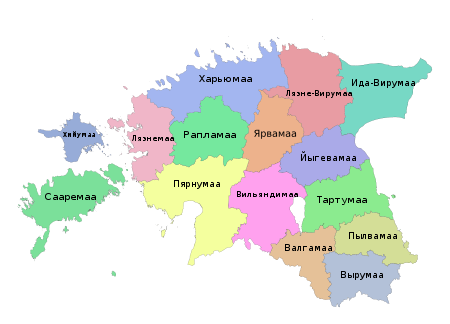
![]()
(При нажатии на изображение (название) какого-либо уезда, будет осуществлён переход на соответствующую статью.)
- A, В и С — Таллин
- D — Вильяндимаа
- F — Пярнумаа
- G — Валгамаа
- H — Хийумаа
- I — Ида-Вирумаа исключая Нарва
- J — Йыгевамаа
- K — Сааремаа (K — Курессааре)
- L — Рапламаа
- M — Харьюмаа исключая Таллин
- N — Нарва
- O — Пылвамаа
- P — Ярвамаа
- R — Ляэне-Вирумаа
- S — Ляэнемаа
- T — Тартумаа
- V — Вырумаа
Типы выдаваемых номеров
- Общий — выдаётся легковому и грузовому транспорту независимо от формы регистрации, вид номера показан в начале статьи (например, «135 ADB»).
- Для автомобилей с американским стандартом номерных знаков, формат: «две цифры три буквы», первая буква всегда «Z» (например, «12 ZCL»).
- Для автомобилей, зарегистрированных иностранными гражданами, формат: «три цифры три буквы», первые две буквы всегда «EE» (например, «136 EEF»), выполняется чёрными символами на светло-оранжевом фоне.
- Для прицепов, формат «три цифры две буквы» (например, «148 AL»).
- Мотоциклетный, формат «две цифры две буквы» (например, «12 AB»).
- Дипломатический, формат «две буквы четыре цифры» или «три буквы три цифры», выполняется белыми символами на голубом фоне. Первый формат используется для автомобилей сотрудников посольств (первые две буквы «CD») или представительств (первые две буквы «AT»), второй формат используется только на личных автомобилях послов и консулов, буквы обязательно «CMD». Первые две цифры в обоих номерах — код страны.
- Транзитный, формат «две буквы — четыре цифры» (например, «AF — 2365»), выполняется красными буквами на белом фоне.
- Военный, формат совпадает с форматом общего, прицепного или мотоциклетного номеров (в зависимости от типа зарегистрированного транспортного средства), но выполняются белыми символами на чёрном фоне.
Примечания
См. также
- Автомобильный код
- Дорожное движение
Ссылки
Официальный сайт Департамента шоссейных дорог Эстонии
| | |
|---|---|
| Австрия | Азербайджан | Албания | Андорра | Армения | Беларусь | Бельгия | Болгария | Босния и Герцеговина | Великобритания | Венгрия | Германия | Греция | Грузия | Дания | Ирландия | Исландия | Испания | Италия | Казахстан | Кипр | Латвия | Литва | Лихтенштейн | Люксембург | Македония | Мальта | Молдавия | Монако | Нидерланды | Норвегия | Польша | Португалия | Россия | Румыния | Сан-Марино | Сербия | Словакия | Словения | Турция | Украина | Финляндия | Франция | Хорватия | Черногория | Чехия | Швейцария | Швеция | Эстония | |
| Зависимые территории: | Акротири и Декелия | Аландские острова | Гернси | Гибралтар | Джерси | Остров Мэн | Фарерские острова | Шпицберген | Ян-Майен |
| Непризнанные и частично признанные государства: | Абхазия | Косово | Нагорно-Карабахская Республика | Приднестровье | Турецкая Республика Северного Кипра | Южная Осетия |
| Бывшие государства: | ГДР | СССР | Чехословакия | Югославия |



Регистрационный номерной знак (b) Эстонии (b) состоит из трех цифр и через пробел (b) трех букв. Первая буква в номере обозначает регион, в котором выдан регистрационный знак. После вступления Эстонии (b) в Европейский союз (b) в левой части знака располагается синий прямоугольник с символом ЕС и инициалами EST.
История
До 1929 года единого стандарта автомобильных номеров не существовало — Эстония заимствовала принцип погубернской регистрации, действовавший в Российской империи. В каждой губернии существовал свой вид регистрационных знаков, отличавшихся в основном цветовой гаммой. В качестве номера автомобиля чаще всего выступало трёх-четырёхзначное число.
Первые единые эстонские автомобильные номера появились во время I Эстонской республики, в 1929 году.
В 1933 году (b) вид номеров слегка изменился, а в 1938 ещё слегка модернизировался.
В 1940—1941 годах на территории Эстонии выдавались автономера советского образца, но латинописной серии ER.
В 1941—1944 годах территория Эстонии была оккупирована немецкими войсками и входила в Рейхскомиссариат Остланд (b) . В этот период на территории выдавались номерные знаки рейхскомиссариата, начинающиеся с RO.
С 1944 по 1991 год на территории Эстонии вновь выдавались государственные регистрационные знаки СССР (b) общереспубликанских серий, принадлежащих Эстонской ССР (b) (общереспубликанские серии ЕА и ЭС).
С 1991 года (b) на территории Эстонии вновь начата выдача номерных знаков собственного стандарта, однако советские номера продолжали иметь законную силу.
С 1 июля (b) 2001 года (b) на территории Эстонии прекращено действие советских номеров.
В 2004 году (b) , после вступления Эстонии (b) в Европейский союз (b) , в левой части номеров появилась синяя вертикальная полоса с флагом ЕС и автомобильным кодом Эстонии «EST», формат номеров остался без изменений.
Обозначения регионов на номерах
До 1995—1996 года первая буква обозначала регион регистрации транспортного средства:
- A, В и С — Таллин (b)
- D — Вильяндимаа (b)
- F — Пярнумаа (b)
- G — Валгамаа (b)
- H — Хийумаа (b)
- I — Ида-Вирумаа (b) , исключая Нарву (b)
- J — Йыгевамаа (b)
- K — Сааремаа (b) (K — Курессааре (b) )
- L — Рапламаа (b)
- M — Харьюмаа (b) , исключая Таллин (b)
- N — Нарва (b)
- O — Пылвамаа (b)
- P — Ярвамаа (b)
- R — Ляэне-Вирумаа (b)
- S — Ляэнемаа (b)
- T — Тартумаа (b)
- V — Вырумаа (b) .
После 1996 года (b) буквенное обозначение сохранилось лишь для Таллина и Тартумаа, в остальных уездах действует обозначение «М».[источник не указан 3434 дня]
Коды стран на дипломатических номерах
| Код | Страна |
|---|---|
| 10 | |
| 11 | |
| 12 | |
| 13 | |
| 14 | |
| 15 | |
| 16 | |
| 17 | |
| 18 | |
| 19 | |
| 20 | |
| 21 | |
| 22 | ? |
| 23 | |
| 24 | |
| 25 | |
| 26 | |
| 27 | |
| 28 | |
| 29 | |
| 30 | |
| 31 | ? |
| 32 | ? |
| 33 | |
| 34 | |
| 35 | |
| 36 | |
| 39 | |
| 43 | |
| 44 | |
| 49 | |
| 50 | |
| 52 | ? |
Типы выдаваемых номеров
- Общий — выдаётся легковому, грузовому транспорту и автобусам независимо от формы собственности, формат: «три цифры три буквы». C 2010 года в переменной части регулярных номерных знаков не используются гласные буквы (A, E, I, O, U, Y). На номерах старого образца, выдаваемых до 2004 года, две маленькие цифры напечатанные вертикально по середине номера обозначали год следующего тех. осмотра.
- Индивидуальный. Владелец автомобиля по желанию может заказать себе индивидуальный номер с произвольным сочетанием букв и цифр. Основное требование — номер должен содержать как минимум букву и цифру, максимальное число символов в номере не должно превышать семи, включая пробелы. Индивидуальный номер выдаётся за дополнительную плату. Существует 2 вида индивидуальных номеров: «заказная серия» и полностью индивидуальный номер. Заказная серия — это произвольное сочетание цифр и букв, не нарушающее формата (например, «666 USA»); по состоянию на 2016 год такой номер стоит 470 евро (b) . Индивидуальный номер — номер с абсолютно произвольным сочетанием букв и цифр (например, «RUSSIA7»); такие номера, конечно, интереснее, но стоят в 3 раза дороже заказных серий.
- Дилерские номера для тест-драйва. Первое время дилерские номера были того же формата, что и обычные, но выполнялись белыми символами на зелёном фоне. Просуществовали такие номера недолго и уже в середине 1990-х годов были заменены номером текущего стандарта, формат: PROOV и четыре цифры, цветовая гамма — как у обычных номеров. Для автомобилей американского и японского производств существует двухрядное исполнение номерного знака: в верхнем ряду располагается слово «PROOV», в нижнем — цифры.
- Для автомобилей с американским стандартом номерных знаков, формат: «две цифры три буквы», первая буква всегда Z (при заказе серии можно выбрать любое сочетание букв), пластина номера короче, но шире.
- Для автомобилей, зарегистрированных иностранными гражданами, формат: «три цифры три буквы», первые две буквы всегда EE, выполняется чёрными символами на жёлтом фоне. Для автомобилей американского производства применяется сокращённый формат, число цифр в нём на одну меньше, буквосочетание чаще всего EEZ. На текущий момент, данный вид знака выдаётся в крайне редких случаях.
- Для прицепов. До 2009 года формат прицепных номеров был «три цифры две буквы», в 2009—2010 году на прицепы стали выдавать автомобильные номера американского стандарта (первая буква была H, последняя — Z), с 2010 года формат прицепных номеров совпадает с автомобильными, первая буква номера — Y.
- Мотоциклетный. До 2001 года мотоциклетные номера были двухрядные, сверху располагались три цифры, снизу — две буквы, форма пластины — вытянутый по вертикали прямоугольник. В 2001 году формат был сменён на однорядный «две цифры две буквы». Как на автомобили, на мотоциклы можно заказать индивидуальный номер.
- Для мопедов, формат: «три цифры буква», выполняется чёрными символами на зелёном (ранее — салатовом) фоне, введён с 1 июля 2011 года.
- Дипломатический, выдаётся с 1995 года. Формат: «две буквы четыре цифры» (до 1996 года первая цифра печаталась слитно с буквами) или «три буквы три цифры», выполняется белыми символами на голубом фоне. Первый формат используется для автомобилей сотрудников посольств (первые две буквы CD) или техперсонала (первые две буквы AT), второй формат используется только на личных автомобилях послов и консулов, буквы обязательно CMD. Первые две цифры в обоих номерах — код страны. Для автомобилей американского производства применяются сокращённые форматы, число цифр в них на одну меньше.
- Транзитный, формат: «две буквы — четыре цифры» (для автомобилей, в исключительных случаях — для прицепов) или «две буквы — три цифры» (для прицепов, тракторов, мотоциклов и мопедов), выполняются красными символами на белом фоне.
- Военный, формат совпадает с форматом общего, прицепного, мотоциклетного или тракторного номеров (в зависимости от типа зарегистрированного транспортного средства), но выполняются белыми символами на чёрном фоне; синяя полоса с флагом ЕС и кодом Эстонии отсутствует. Для автомобилей также предусмотрен «американский» вариант, а с 2013 года — и двухрядный вариант номера.
- Для тракторов и тракторных прицепов. В 1991—1992 годах существовал переходный вариант номера: форма пластин, формат номеров и даже серии полностью повторяли последний советский стандарт, но при этом использовались латинские буквы. В 1992 году обоим номерам придали квадратную форму и увеличили шрифт, оставив форматы («четыре цифры в верхнем ряду, две буквы — в нижнем» для тракторов и обратный формат — для тракторных прицепов). С 2004 года на номерах появилась синяя полоса с флагом Евросоюза и кодом «EST», поменялись и серии — теперь на трактора стали выдавать серии ТА и ТЕ, а на прицепы — TN. В 2009 году отдельный формат для тракторных прицепов был отменён, вся сельхозтехника и прицепы к ней теперь регистрируются номерами тракторного формата серии TH, тогда же ввели однорядную разновидность тракторного номера в формате «четыре цифры две буквы».
- Номера ретро-техники. На старые автомобили и мотоциклы можно получить свой вид номерных знаков: выполняются белыми символами на чёрном фоне, форматы — буква М и три цифры для мотоциклов, буква А и три или четыре цифры для автомобилей. До октября 2008 года на номерах помещался прямоугольник с евросимволикой, после октября 2008 года его перестали помещать на номерной знак. На такие номера также имеется возможность купить заказную серию, но не индивидуальный номер.
- Номера спортивных автомобилей. Формат номера: «SP четыре цифры», слева — синий прямоугольник с евросимволикой, выполняется белыми символами на красном фоне, введён в 2009 году. Спереди номер наклеивается и имеет меньше размер чем задний номер, а задний имеет стандартную форму и металлическое основание.
- Президентский номер. Представляет собой белую пластину с нарисованным посередине гербом Эстонии (b) .
 |   |
|  |  | |
| Автомобильные номера | Номера мотоциклов (сверху) и мопедов (снизу) | Прицепной номер до 2009 года (сверху) и современный (снизу) | Тракторные номера | Номера ретромобилей и ретро-мотоциклов | Номер для спортивного автомобиля |
  |  | ||||
| Транзитные номера | Дилерский автомобильный номер | Дипломатические автомобильные номера | Военные номера | Автомобильный номер иностранных граждан | Автомобильный номер Президента Эстонии |
Номерные знаки до 1940 года
Единые номера в Эстонии появились в 1929 году. Номер представлял собой чёрную табличку, на которой белым цветом было написано буквенное обозначение региона, дефис и цифры (до четырёх). Военные номера имели белую табличку и первой букву К (Kaitseministeerium).
В 1933 году вид номеров слегка изменился, на них в левом верхнем углу начали проставлять последние две цифры года выдачи, а под ним — печать Эстонской республики. Также от чётности/нечётности года зависел фон номерного знака: чётные года — белый, нечётные — чёрный.
В 1938 году год выдачи номера стали писать над дефисом. Тогда же появились «дилерские» номера, отличавшиеся от регулярных номеров красным цветом букв и цифр.
Обозначения регионов на номерах
Региональные обозначения не совпадают с современными, а соответствуют административно-территориальному делению Эстонии в период 1918—1940 годов:
- A — Таллин (b)
- B — Тарту (b)
- E — Нарва (b)
- H — Харьюмаа (b) исключая Таллин (b)
- J — Ярвамаа (b)
- K — Вооружённые силы
- L — Ляэнемаа (b) (включая острова Хийюмаа и Вормси)
- N — Петсери (b) (ныне Печорский район (b) Псковской области (b) )
- O — Вырумаа (b)
- P — Пярнумаа (b)
- R — Валгамаа (b)
- S — Сааремаа (b)
- T — Тартумаа (b)
- U — Вирумаа (b)
- V — Вильяндимаа (b)
Примечания
См. также
- Автомобильный код (b)
- Дорожное движение (b)
Ссылки
- Официальный сайт Департамента шоссейных дорог Эстонии
- Сайт истории и современности эстонских номерных знаков
- Приложение к закону о транспорте
Arabic
Bulgarian
Chinese
Croatian
Czech
Danish
Dutch
English
Estonian
Finnish
French
German
Greek
Hebrew
Hindi
Hungarian
Icelandic
Indonesian
Italian
Japanese
Korean
Latvian
Lithuanian
Malagasy
Norwegian
Persian
Polish
Portuguese
Romanian
Russian
Serbian
Slovak
Slovenian
Spanish
Swedish
Thai
Turkish
Vietnamese
Arabic
Bulgarian
Chinese
Croatian
Czech
Danish
Dutch
English
Estonian
Finnish
French
German
Greek
Hebrew
Hindi
Hungarian
Icelandic
Indonesian
Italian
Japanese
Korean
Latvian
Lithuanian
Malagasy
Norwegian
Persian
Polish
Portuguese
Romanian
Russian
Serbian
Slovak
Slovenian
Spanish
Swedish
Thai
Turkish
Vietnamese
sensagent‘s content
- definitions
- synonyms
- antonyms
- encyclopedia
Webmaster Solution
Alexandria
![]() A windows (pop-into) of information (full-content of Sensagent) triggered by double-clicking any word on your webpage. Give contextual explanation and translation from your sites !
A windows (pop-into) of information (full-content of Sensagent) triggered by double-clicking any word on your webpage. Give contextual explanation and translation from your sites !
Try here or get the code
SensagentBox
With a SensagentBox, visitors to your site can access reliable information on over 5 million pages provided by Sensagent.com. Choose the design that fits your site.
Business solution
Improve your site content
Add new content to your site from Sensagent by XML.
Crawl products or adds
Get XML access to reach the best products.
Index images and define metadata
Get XML access to fix the meaning of your metadata.
Please, email us to describe your idea.
Lettris
Lettris is a curious tetris-clone game where all the bricks have the same square shape but different content. Each square carries a letter. To make squares disappear and save space for other squares you have to assemble English words (left, right, up, down) from the falling squares.
boggle
 Boggle gives you 3 minutes to find as many words (3 letters or more) as you can in a grid of 16 letters. You can also try the grid of 16 letters. Letters must be adjacent and longer words score better. See if you can get into the grid Hall of Fame !
Boggle gives you 3 minutes to find as many words (3 letters or more) as you can in a grid of 16 letters. You can also try the grid of 16 letters. Letters must be adjacent and longer words score better. See if you can get into the grid Hall of Fame !
English dictionary
Main references
Most English definitions are provided by WordNet .
English thesaurus is mainly derived from The Integral Dictionary (TID).
English Encyclopedia is licensed by Wikipedia (GNU).
Translation
Change the target language to find translations.
Tips: browse the semantic fields (see From ideas to words) in two languages to learn more.
4186 online visitors
computed in 0.031s
I would like to report:
section :
a spelling or a grammatical mistake
an offensive content(racist, pornographic, injurious, etc.)
a copyright violation
an error
a missing statement
other
please precise:
Cookies help us deliver our services. By using our services, you agree to our use of cookies.
Find out more




